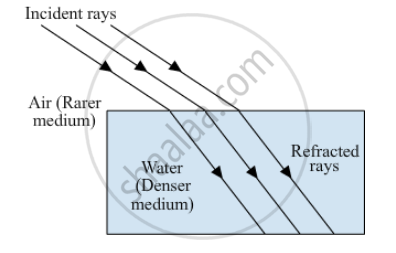Advertisements
Advertisements
प्रश्न
A beam of light travelling in air is incident of water. Draw a ray-diagram indicating the change in its path in water.
उत्तर
When a beam of light travelling in air enters water, it bends towards the normal.

APPEARS IN
संबंधित प्रश्न
(a) Draw a ray diagram to show the formation of an image by a convex lens when an object is placed in front of the lens between its optical centre and principal focus.
(b) In the above ray diagram, mark the object distance (u) and the image distance (v) with their proper signs (+ve or –ve as per the new Cartesian sign convention) and state how these distances are related to the focal length (f) of the convex lens in this case.
(c) Find the power of a convex lens which forms a real and inverted image of magnification –1 of an object placed at a distance of 20 cm from its optical centre.
When a ray of light enters from one medium to another having different optical densities it bends. Why does this phenomenon occur?
What type of lens is shown in the diagram on the right? What will happen to the parallel rays of light? Show by completing the ray diagram.
Describe the nature of image formed when an object is placed at a distance of 30 cm from a convex lens of focal length 15 cm.
An object 3 cm high is placed 24 cm away from a convex lens of focal length 8 cm. Find by calculations, the position, height and nature of the image.
A student did an experiment with a convex lens. He put an object at different distances 25 cm, 30 cm, 40 cm, 60 cm and 120 cm from the lens. In each case he measured the distance of the image from the lens. His results were 100 cm, 24 cm, 60 cm, 30 cm and 40 cm, respectively. Unfortunately his results are written in wrong order.
Rewrite the image distances in the correct order.
Complete the following sentence.
A long-sighted person cannot see ........... objects clearly. Long-sightedness can be corrected by using .............. lenses.
The image obtained while finding the focal length of convex lens is ....................
How will you decide whether a given piece of glass is a concave lens, convex lens, or a plane glass plate?
